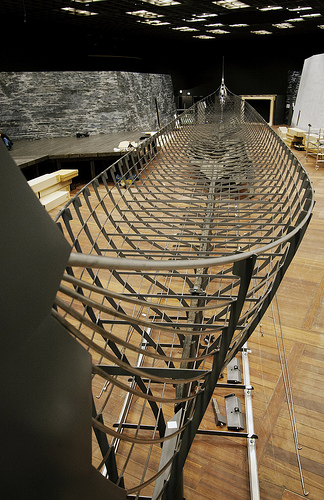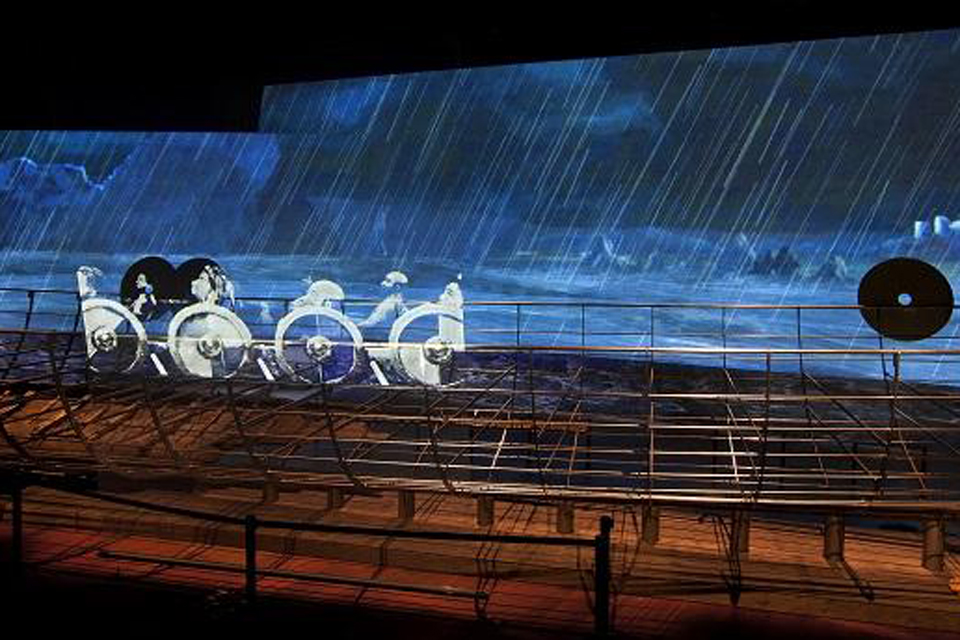Heave to Copenhagen, where the Vikings are on show all summer and autumn
 The ship is at the centre. Frightening in its might, it cannot but make us all tremble from its sheer size. It was built in 1025 in Norway, later repaired in Denmark and finally laid to rest in 1039. Its length was 37 metres and it held 39 thwarts or banks or 78 oars. It has been estimated to be able to carry a crew of app. 100 men. The sail was probably 120 m2. 25% of the ship was found in the harbour at Roskilde in 1997 and it took 15 years to impregnate, freeze-dry and mount the ship on the carefully executed frame made out of stainless steel.
The ship is at the centre. Frightening in its might, it cannot but make us all tremble from its sheer size. It was built in 1025 in Norway, later repaired in Denmark and finally laid to rest in 1039. Its length was 37 metres and it held 39 thwarts or banks or 78 oars. It has been estimated to be able to carry a crew of app. 100 men. The sail was probably 120 m2. 25% of the ship was found in the harbour at Roskilde in 1997 and it took 15 years to impregnate, freeze-dry and mount the ship on the carefully executed frame made out of stainless steel.
And yet: even as a wreck, it is still a mighty ship! Stand next to it and you get a new feeling for the seaworthy warriors from the North, who were able to terrorise their neighbours to a degree, which at first felt like a constant plunder, but later turned into a true and proper conquest – first of Ireland and the Western part of England, then Normandy, later the whole of England and finally the Baltic Coast from Jutland to Estonia.
As a Dane it is amusing to note that very few English children are told how they are nothing but descendants of the constant influx of Scandinavians, who conquered the Isles from 400 AD and onwards; and crowning their victory in a series of conquests from 991 to 1066. (Hopefully, the exhibition, which moves to the British Museum in London this autumn will teach them otherwise!).
What did the ship witness? We don’t know. But it was definitely a warship designed to transport troops, horses and warriors across the North Sea. There must have been hundreds of ships like her, when ten years earlier in 1013 the mighty fleet of Swein Forkbeard and his son Canute the Great, once again sailed to England in August and landed, first at Sandwich and then following the coast up towards the North. This expedition was the culmination of decades of ravaging by Danes and Norwegians, whereby the English became obliged to pay hefty ransoms of “Danegeld”. It ended up in Swein and later his son being elected kings of England.
Very properly a new story is now told about the Vikings using the ship as the backbone. Since the National Museum in Copenhagen last mounted such a grand exhibition of the Vikings (in 1992) tons and loads of new finds from archaeological excavations have helped to solve a series of enigmatic puzzles, which formerly characterised the understanding of what these Vikings were all about.
Letting them loose
In a sense the exhibition finally lets the Vikings loose. Of course the real story about the Vikings was never quite forgotten. But for a long time the story was decidedly twisted for political reasons. On one hand a significant group of archaeologists in the 20th century fought to dispel the study of the Vikings as anything but the descendants of Iron Age Scandinavians. Hence they were labelled as “People from the Late Iron Age” while the word “Viking” was tabooed. At the same time archaeologists, who did work on and write about the Viking Age, tried to minimise their reputation as foremost warriors. Nay, the Vikings were for the most part just friendly and competent tradesmen, supplementing their income as farmers, we were told 30 to 40 years ago. For years visitors to the standing exhibition at The National Museum were thus not told the story about the Vikings; to their consternation and frustration they were presented with the story of “the end of the Iron Age”.
However, now it seems, scholars and researchers have finally come together focusing in on the ship in order to tell a different and more trustworthy story of the Vikings, dispelling this “cold-war-myth” engendered by pacifist, leftist archaeologist. They were really and maybe still are a vile bunch!
Carefully sifting the enormous results yielded by the excavations of the same archaeologists as well as rereading the sources from a historical anthropological point of view, it seems a new generation have come forward and produced this new and fresh view of what the Vikings were all about. War, we are told. And plunder, murder and heathen sacrifices as well as trade, wealth, art and gift-giving connoisseurs with an open mind towards other people, cultures and gods.
Entering the exhibition the visitor is thus given the first glimpse of the ship through a peephole in the walls fencing the piece-de-resistance, while the sounds from the roar of waves, wind and fighting presents us with a constant murmur of the sea. Nevertheless it is important to navigate slowly through the different parts of the exhibition telling us in detail about the international and cultural connections in the Viking World, the Viking way of plunder and conquests, the elites who organised and profited from all this and finally the belief-systems of the heathen Vikings on the brink of early Christianity. Moving through these four sections the visitor is constantly reminded of the ship and its central role – as communicative tool, as weapon, as icon and as myth (Follow the links below and read more about the details of the different parts of the exhibition).
It is a remarkable exhibition. A true joy for the connoisseur, it is a distinct pleasure to see all the most magnificent pieces collected in one place. For the less knowledgeable it might also works as a can-opener with the grandiose ship in the centre contextualising all the glittering things on show. However, the choice, which has been made concerning the terse explanations encountered on the sides of the showcases, is problematic. Queuing is to be expected for those of the visitors who are not fashionable enough to be the owners of smart phones (rumour is there will be an app). Remember to get the catalogue up front and read beforehand.
Finally it should be mentioned that an amusing game has been developed for youngsters interested in trying to mount their own expedition. There is definitely also room for children.
Well worth a travel around the world! And if you can’t make it this summer and autumn, the exhibition moves on to The British Museum and later Berlin in 2013 -14. But remember: catch it while you can!
Read more about the different sections of the exhibition here:
- The multicultural world of the Vikings
- The warring and plundering of the Vikings
- The world of Viking splendour and gift-giving
- The world of Viking myths and religion
Viking 2013
The National Museum in Copenhagen
22.06.2013 – 17.11.2013
READ MORE:
Viking – The National Museum of Denmark Special Exhibition 2013 – English Catalogue
By Peter Pentz, Gareth Williams, Matthias Wemhoff
The National Museum of Denmark 2013-06-21
ISBN-nummer: 9788776022006
Price: €26,40
